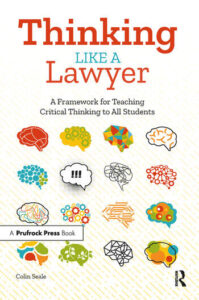ThinkLaw Strategies Can Grow Critical Thinkers
Thinking Like a Lawyer: A Framework for Teaching Critical Thinking to All Students
By Colin Seale
(Routledge/Prufrock Press, 2020 – Learn more)
Reviewed by Kimberly Rensch

Balancing academic standards with those soft skills that students need to be productive citizens is tricky at best.
Any book that reads quickly and offers reasonable ways to integrate thinking skills with academic curricula is worth reading. Thinking Like a Lawyer by former math teacher turned attorney Colin Seale is such a book.
Lots to Chew On

He charges educators with the monumental task of “equip[ping] students with the navigational and inquiry tools they need to learn how to learn and apply this learning across disciplines” (16) because “[t]he wisest scholars are those who have the awareness to understand what they do not know and the truth-seeking impulse to thoroughly investigate questions to reach a workable depth of content knowledge” (16-17).
Seale presents his call for developing students’ critical thinking skills in three parts: Closing the Critical Thinking Gap; Thinking Like a Lawyer; and Practical Considerations for a Critical Thinking Revolution.
Part One: Why critical thinking?
The book’s first three chapters begin with a vulnerable Seale describing his complicated school career and the path he took to believing that all students deserve to be taught critical thinking skills. He recounts a pivotal moment late in high school when a teacher’s belief in his potential helped him turn a corner and graduate on a high note.
Seale devotes the remainder of Part One to defining critical thinking and laying out why it is so important for students to develop critical thinking skills in order “to ensure an active and engaged citizenry” (24). Readers will appreciate Seale’s enhanced definition of critical thinking, including both skills and dispositions of critical thinkers.
Part Two: Lawyerly skills
At the heart of this book is Colin Seale’s simile, Thinking Like a Lawyer, or thinkLaw for short.

It is a common belief that a child prone to arguing should someday become a lawyer, but Seale sets the record straight on the skills that lawyers really need.
He wraps these skills up into four strategies, each of which gets a chapter with an explanation, a connection to a real-life legal case, and a sample activity for each core content area (language arts, science, math, and social studies). The one exception is the strategy called Analysis From Multiple Perspectives, which gets a two-chapter treatment because, according to Seale, it is the “fundamental thinkLaw strategy” (45).
Teachers will appreciate the fact that chapters read quickly, yet are packed full of helpful little nuggets, like graphic organizers, rubrics, and Seale’s own modeling of how to think through a legal case that highlights the critical thinking strategy featured in each chapter.
One limitation that might frustrate some is that example activities are not listed for elective and encore classes (health, PE, world languages, etc.), but teachers are nothing if not creative and resourceful and should be able to develop critical thinking opportunities for their disciplines based on the tools already available in each chapter.
Part Three: Reframing help
Seale doesn’t just dump the thinkLaw strategies in readers’ laps and wish us luck. The book’s final five chapters address “practical considerations” to bringing thinkLaw to life in our classrooms. He sets out to reframe our thinking on students with disruptive behaviors, explaining how these students may be our best innovators and most likely to succeed at thinking critically.
One chapter even addresses how we can leverage critical thinking opportunities to best prepare students for state assessments. Seale’s final chapter encourages schools to engage parents and families as partners in developing children’s critical thinking skills.
Final Thoughts: Good for all students
Though published by Prufrock Press, a publishing company specializing in resources for teachers of gifted and high ability students (and now owned by Routledge), Thinking Like a Lawyer is for teachers of all students. As the author frequently notes, sometimes our students who struggle the most end up being our best out-of-the-box thinkers.
And one final consideration centers on grading. I know from experience that school districts looking to bring 21st century skills into their classrooms have had many conversations about how to assess and, consequently, grade these skills – as grades are an unfortunate reality for most teachers. Other than some rubrics with points, Seale does not spend much time addressing how to grade critical thinking activities. Some of his strategies make good bell work and do not require scoring.
For other strategies, Seale shows how to integrate them with existing standards and curricula (e.g., teaching students how to consider many perspectives before coming up with a claim in argumentative writing). It is likely that a focus on critical thinking will increase student engagement, thus improving the quality of their work and raising grades.
Kim Rensch (@KJRensch) is a National Board Certified Teacher working as a member of the Gifted Services team for Fargo Public Schools in North Dakota. She is also a Teacher-Consultant in the Red River Valley Writing Project. When she’s not doing something school-related, Kim can be found at church or spending time with her husband, their dogs, or her many plants and flowers.




































